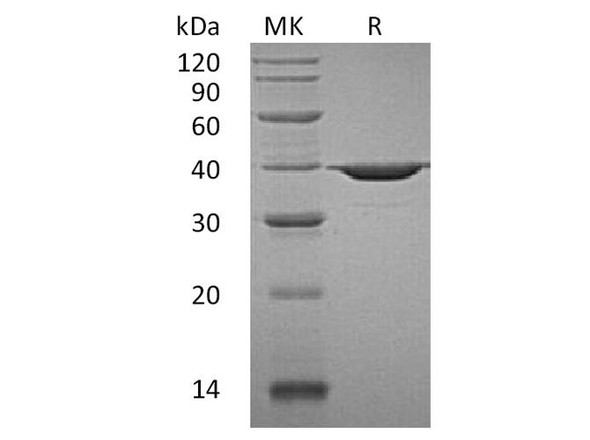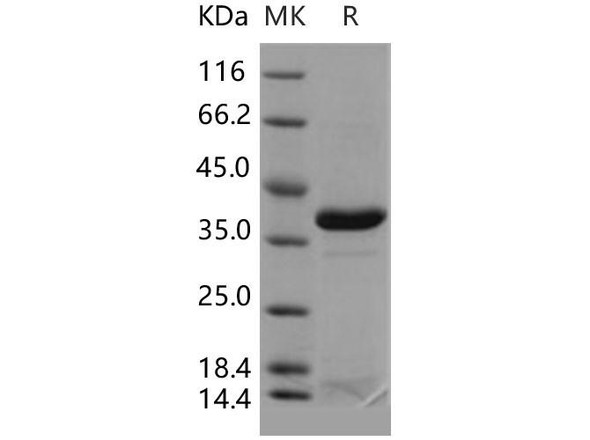Epigenetics & Nuclear Signaling Antibodies 5
Anti-APE1 Antibody (CAB11238)
- SKU:
- CAB11238
- Product Type:
- Antibody
- Reactivity:
- Human
- Reactivity:
- Mouse
- Reactivity:
- Rat
- Host Species:
- Rabbit
- Isotype:
- IgG
- Antibody Type:
- Monoclonal Antibody
- Research Area:
- Epigenetics and Nuclear Signaling
Description
| Antibody Name: | Anti-APE1 Antibody |
| Antibody SKU: | CAB11238 |
| Antibody Size: | 20uL, 50uL, 100uL |
| Application: | WB IHC |
| Reactivity: | Human, Mouse, Rat |
| Host Species: | Rabbit |
| Immunogen: | A synthesized peptide derived from human APE1 |
| Application: | WB IHC |
| Recommended Dilution: | WB 1:500 - 1:2000 IHC 1:50 - 1:200 |
| Reactivity: | Human, Mouse, Rat |
| Positive Samples: | HeLa, 293T, A-431, NIH/3T3, Mouse brain, Rat testis |
| Immunogen: | A synthesized peptide derived from human APE1 |
| Purification Method: | Affinity purification |
| Storage Buffer: | Store at -20°C. Avoid freeze / thaw cycles. Buffer: PBS with 0.02% sodium azide, 0.05% BSA, 50% glycerol, pH7.3. |
| Isotype: | IgG |
| Sequence: | Email for sequence |
| Gene ID: | 328 |
| Uniprot: | P27695 |
| Cellular Location: | |
| Calculated MW: | 36kDa |
| Observed MW: | 36KDa |
| Synonyms: | APE, APE1, APEN, APEX, APX, HAP1, REF1 |
| Background: | Apurinic/apyrimidinic (AP) sites occur frequently in DNA molecules by spontaneous hydrolysis, by DNA damaging agents or by DNA glycosylases that remove specific abnormal bases. AP sites are pre-mutagenic lesions that can prevent normal DNA replication so the cell contains systems to identify and repair such sites. Class II AP endonucleases cleave the phosphodiester backbone 5' to the AP site. This gene encodes the major AP endonuclease in human cells. Splice variants have been found for this gene; all encode the same protein. [provided by RefSeq, Jul 2008] |
| UniProt Protein Function: | APE1: a multifunctional enzyme that plays a central role in the cellular response to oxidative stress including DNA repair and redox regulation of transcriptional factors. Binds DNA and RNA. Functions as an apurinic/apyrimidinic (AP) endodeoxyribonuclease in the DNA base excision repair (BER) pathway, a 3'-5' exoribonuclease for mismatched deoxyribonucleotides at the 3' termini of nicked or gapped DNA molecules, and a DNA 3' phosphodiesterase capable of removing lesions (such as phosphoglycolate) blocking the 3' side of DNA strand breaks. Is a loading factor for POLB onto non-incised AP sites in DNA, stimulates the 5'-terminal deoxyribose 5'- phosphate (dRp) excision activity of POLB, and involved in the DNA cleavage step of class switch recombination (CSR). Possesses reversible nuclear redox activity to regulate DNA binding affinity and transcriptional activity of transcriptional factors by controlling the redox status of their DNA-binding domain, such as the FOS/JUN AP-1 complex after exposure to IR. Binds to negative calcium response elements (nCaREs). Stimulates the YBX1-mediated MDR1 promoter activity, when acetylated at Lys-6 and Lys-7, leading to drug resistance. Is an endoribonuclease involved in the control of single-stranded RNA metabolism. Plays a role in regulating MYC mRNA turnover. In association with NMD1, plays a role in the rRNA quality control process during cell cycle progression. Interacts with SIRT1; the interaction is increased in the context of genotoxic stress. Interacts with HDAC1, HDAC2 and HDAC3; the interactions are not dependent on the APEX1 acetylation status. Up-regulated in presence of reactive oxygen species (ROS), like bleomycin, H2O2 and phenazine methosulfate. NPM1 stimulates endodeoxyribonuclease activity on double-stranded DNA with AP sites, but inhibits endoribonuclease activity on single-stranded RNA containing AP sites. Belongs to the DNA repair enzymes AP/ExoA family. |
| UniProt Protein Details: | Protein type:Endoplasmic reticulum; Deoxyribonuclease; Hydrolase; Transcription, coactivator/corepressor; Nuclear receptor co-regulator; Lyase; Nucleolus; EC 4.2.99.18; DNA-binding; DNA repair, damage Chromosomal Location of Human Ortholog: 14q11.2 Cellular Component: centrosome; cytoplasm; endoplasmic reticulum; mitochondrion; nuclear chromosome, telomeric region; nuclear speck; nucleolus; nucleoplasm; nucleus; perinuclear region of cytoplasm; ribosome Molecular Function:3'-5' exonuclease activity; chromatin DNA binding; damaged DNA binding; DNA binding; DNA-(apurinic or apyrimidinic site) lyase activity; double-stranded DNA specific 3'-5' exodeoxyribonuclease activity; double-stranded DNA specific exodeoxyribonuclease activity; double-stranded telomeric DNA binding; endodeoxyribonuclease activity; endonuclease activity; metal ion binding; oxidoreductase activity; phosphodiesterase I activity; phosphoric diester hydrolase activity; protein binding; ribonuclease H activity; site-specific endodeoxyribonuclease activity, specific for altered base; transcription coactivator activity; transcription corepressor activity; uracil DNA N-glycosylase activity Biological Process: base-excision repair; base-excision repair, base-free sugar-phosphate removal; DNA repair; positive regulation of DNA repair; regulation of mRNA stability; telomere maintenance |
| NCBI Summary: | Apurinic/apyrimidinic (AP) sites occur frequently in DNA molecules by spontaneous hydrolysis, by DNA damaging agents or by DNA glycosylases that remove specific abnormal bases. AP sites are pre-mutagenic lesions that can prevent normal DNA replication so the cell contains systems to identify and repair such sites. Class II AP endonucleases cleave the phosphodiester backbone 5' to the AP site. This gene encodes the major AP endonuclease in human cells. Splice variants have been found for this gene; all encode the same protein. [provided by RefSeq, Jul 2008] |
| UniProt Code: | P27695 |
| NCBI GenInfo Identifier: | 113984 |
| NCBI Gene ID: | 328 |
| NCBI Accession: | P27695.2 |
| UniProt Secondary Accession: | P27695,Q969L5, Q99775, |
| UniProt Related Accession: | P27695 |
| Molecular Weight: | 35,555 Da |
| NCBI Full Name: | DNA-(apurinic or apyrimidinic site) lyase |
| NCBI Synonym Full Names: | apurinic/apyrimidinic endodeoxyribonuclease 1 |
| NCBI Official Symbol: | APEX1 |
| NCBI Official Synonym Symbols: | APE; APX; APE1; APEN; APEX; HAP1; REF1 |
| NCBI Protein Information: | DNA-(apurinic or apyrimidinic site) lyase |
| UniProt Protein Name: | DNA-(apurinic or apyrimidinic site) lyase |
| UniProt Synonym Protein Names: | APEX nuclease; APEN |
| Protein Family: | DNA-(apurinic or apyrimidinic site) lyase |
| UniProt Gene Name: | APEX1 |
| UniProt Entry Name: | APEX1_HUMAN |







